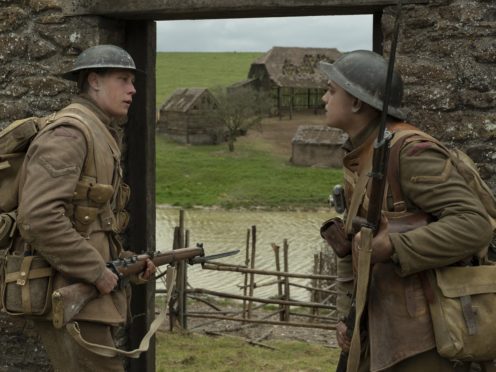Sam Mendes’ First World War epic, 1917, has emerged as one of the big winners from this year’s Golden Globes.
1917 documents the journey of two young soldiers, played by Dean-Charles Chapman and George MacKay, who venture across enemy lines to deliver a message that could save hundreds of lives.
The film, which won the coveted best motion picture (drama) and director’s gong at the star-studded awards ceremony held on Sunday night, is dedicated to the director’s grandfather, as well as the others who served in the armed forces in the Great War.
A stand-out element of the film is the way it has been made, with it being shot as if in one long take, using clever camera work and editing to create a sense of continual motion.
The film’s production notes explain that it was not shot in one take, but rather “filmed in a series of extended, uncut takes that could be connected seamlessly to look and feel as if it is one continuous shot”.
The story line was meticulously mapped out during six months of intense rehearsals, which included daily military drills for the lead actors so they were used to the weight of the uniforms and weapons before filming began.
There is only one way this war ends. Last man standing. From Oscar-winning director Sam Mendes, watch the new 1917 trailer now. In theaters December. #1917Movie pic.twitter.com/kWndUkiuwG
— 1917 (@1917) October 3, 2019
The filmmaker, who received a knighthood in the New Year Honours, said he felt “it was all part of the same two hours of real time, one continuous shot.
“You can’t get out of it, you have to take every step with these men, whether you like it or not.”
Sir Sam added: “But I was also very conscious that it shouldn’t be repetitive or monotonous or just a headlong race.
“Because you’re in one shot, you also have to build into it moments of pause and quiet and reflection and lyricism and all these other things so it feels like it’s constantly shifting and moving rather than it just being this incessant headlong dash.”
#1917Movie wins 2 #GoldenGlobes including Best Picture – Drama and Best Director – Sam Mendes. pic.twitter.com/zuiEnbQTCu
— 1917 (@1917) January 6, 2020
Speaking while promoting the film in the run-up to the Golden Globes, he also spoke about turning his hand to writing the script alongside screenwriter Krysty Wilson-Cairns.
He said: “I had not been a frustrated screenwriter, I just felt like it would be so much easier if I did it myself.
“Otherwise I would have to try to explain it to someone else who then had to write it and I would then tell them it was wrong, so it just seemed like I needed to make the journey between what was in my head and what was on screen as short as possible.

“I thought it would be easier if I just sat down and did the work myself for a change, rather than make it the problem of a screenwriter.
“So I did a lot of work and got a story structure but then I sort of stalled and it was Krysty who put it into screenplay form.”
Cinematographer Roger Deakins, who worked on the film, previously said when asked how many cuts there are in it that it was “a secret but you can probably work it out”.
“We shot somewhere around 65 days and the longest take was probably nine minutes, so do the maths.”

Speaking at a London press conference to promote the film, he added: “The major difficulty was getting across the terrain and doing some of the really intense, sensitive scenes and making it all feel like a piece.
“You’re using a lot of different techniques, the trick was trying to make it feel like one camera all the time – that was the biggest challenge, that and the weather.”
1917 is released in UK cinemas on January 10.
